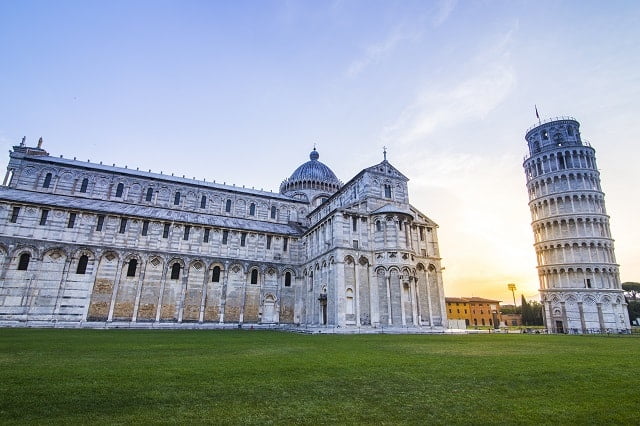Have you ever wondered how to say the word “travel” in Italian? As one of the most beautiful and romantic languages in the world, Italian has a way of bringing the essence of travel to life. From the rolling hills of Tuscany to the picturesque canals of Venice, Italy is a country that embodies wanderlust and adventure. In this article, we will delve into the beauty of the Italian language and explore its connection to the concept of travel.
Italian is a language known for its melodic sound and expressive gestures, making it a perfect medium for capturing the spirit of exploration and discovery. In this section, we will take a closer look at the word “travel” in Italian, delving into its translation, pronunciation, and cultural significance. Whether you’re planning a trip to Italy or simply have an interest in language and culture, understanding how travel is portrayed in Italian society is sure to enrich your experience.
From famous landmarks like the Colosseum in Rome to off-the-beaten-path villages nestled in the Italian countryside, travel is deeply ingrained in Italian culture. We will also explore some of Italy’s most famous travel destinations, discovering what makes them so captivating and irresistible to visitors from around the world.
Additionally, we’ll uncover some unique Italian phrases and expressions related to travel that will add a touch of authenticity to your next adventure in Italy. Join us as we embark on a journey through the enchanting world of Italian language and travel.
Understanding the Word Travel in Italian
The Italian language is a beautiful and romantic language that is widely spoken and appreciated around the world. One of the most common words associated with the beauty and allure of Italy is “travel”. In Italian, the word for travel is “viaggio”. It is pronounced as “vee-ahj-joh”, with the stress on the first syllable.
When it comes to translating travel-related terms in Italian, it’s helpful to familiarize yourself with some basic vocabulary. Here are a few essential travel-related words and phrases in Italian:
- Viaggio – Travel
- Destinazione – Destination
- Prenotazione – Reservation
- Bagaglio – Luggage
- Biglietto – Ticket
In addition to these basic words, it’s important to understand how to ask for directions and navigate transportation in Italian. Knowing how to say “Where is ?” (Dov’è ?) or “How do I get to ?” (Come arrivo a ?) can be incredibly useful when exploring Italy.
For travelers who are looking to immerse themselves in the local culture, mastering the pronunciation of these travel-related terms will undoubtedly enhance their experience in Italy. Whether you are exploring the cobblestone streets of Rome or taking a gondola ride through Venice, having a grasp of basic Italian travel vocabulary will make your journey all the more enriching.
The Cultural Significance of Travel in Italian Society
In Italian society, the act of traveling is often seen as a way to enrich one’s knowledge and experience. As a result, many Italians prioritize travel as a means to broaden their horizons and learn about different customs and traditions. This emphasis on travel has contributed to Italy’s reputation as a global center for art, fashion, and gastronomy.
Moreover, travel plays a significant role in connecting different regions within Italy itself. Each region boasts its own unique attractions and cultural heritage, making internal travel an important aspect of Italian society. From the scenic Amalfi Coast to the historical city of Florence, the diverse landscapes and architectural marvels within Italy make travel both appealing and culturally enriching for locals and visitors alike.
Italy is also known for its vibrant festivals and events that celebrate travel-related themes such as pilgrimage or historic reenactments. These cultural activities underscore the importance of travel in shaping Italian traditions and customs. Whether it’s through religious processions or lively carnivals, these events highlight how deeply ingrained the concept of viaggio is in Italian society.
| Italian Phrase | English Translation |
|---|---|
| “Dov’è la stazione?” | “Where is the train station?” |
| “Quanto costa il biglietto?” | “How much does the ticket cost?” |
| “Posso avere un menu?” | “Can I have a menu?” |
Famous Italian Travel Destinations
Italy is a country rich in history, culture, and landscapes that have attracted travelers from all over the world for centuries. From the ancient ruins of Rome to the romantic canals of Venice, there are countless famous Italian travel destinations that continue to captivate visitors. Here are some of the must-see places when traveling to Italy:
- Rome: The capital city of Italy is home to iconic landmarks such as the Colosseum, the Roman Forum, and the Vatican City. Visitors can immerse themselves in the fascinating history of the Roman Empire while also enjoying modern amenities and vibrant nightlife.
- Florence: Known for its Renaissance art and architecture, Florence is a treasure trove of cultural attractions. The Uffizi Gallery, Ponte Vecchio, and Florence Cathedral are just a few of the highlights that draw travelers to this enchanting city.
- Venice: With its network of picturesque canals and historic palaces, Venice is truly one of a kind. Visitors can take a gondola ride along the Grand Canal, explore St. Mark’s Square, and lose themselves in the maze-like streets of this romantic city.
Traveling beyond these well-known cities also reveals hidden gems such as the stunning Amalfi Coast, the charming villages of Cinque Terre, and the historic ruins of Pompeii. Whether you’re drawn to bustling urban centers or tranquil countryside retreats, Italy offers an abundance of diverse travel experiences.
While visiting these famous Italian travel destinations certainly provides unforgettable memories, it’s also important to embrace local customs and traditions in order to fully appreciate the culture. By learning about Italian phrases and expressions related to travel, as well as understanding travel traditions and customs in Italy, travelers can enrich their experiences and forge meaningful connections with locals.
Influences from Italian travel are not limited to sightseeing alone; they have also left their mark on cuisine and food culture around the world. Italian dishes like pasta, pizza, gelato have become beloved staples in many countries, reflecting the impact of Italian travel on global culinary tastes.
Whether you are planning a trip to Italy or simply want to immerse yourself in its language and culture from afar, familiarizing yourself with these famous Italian travel destinations is an essential step in truly appreciating all that this beautiful country has to offer.
Italian Phrases and Expressions Related to Travel
When learning a new language, it is essential to familiarize oneself with common phrases and expressions related to travel. In Italian, the word for travel is “viaggiare.” This verb is used to convey the act of traveling or journeying from one place to another. It can be conjugated in various tenses and moods to fit different contexts and situations.
Useful Travel Phrases
When visiting Italy, it is helpful to know some basic travel phrases that will facilitate communication with locals. For example, “Dove posso trovare un taxi?” means “Where can I find a taxi?” while “Quanto costa il biglietto?” translates to “How much does the ticket cost?” Mastering these simple phrases can make navigating through Italian cities much easier.
Expressions for Getting Around
In addition to basic travel phrases, understanding expressions related to getting around is also crucial. Expressions like “Andiamo in giro” (Let’s go sightseeing) and “Prendiamo il treno” (Let’s take the train) can help travelers make the most of their experience in Italy. These expressions not only aid in communication but also allow visitors to immerse themselves in the local culture and customs.
Whether you’re planning a trip to the bustling streets of Rome or the romantic canals of Venice, having a grasp of Italian travel phrases and expressions will undoubtedly enhance your overall experience. From asking for directions to ordering local cuisine, embracing the essence of travel in the Italian language adds an extra layer of depth and authenticity to your journey.
Italian Travel Traditions and Customs
Italy is a country rich in tradition and customs when it comes to travel. From the north to the south, Italians have a deep connection to the act of traveling, which is deeply embedded in their culture and history. Whether it’s for leisure, pilgrimage, or visiting family, travel holds great significance in Italian society.
Italian Pilgrimage Tradition
One of the most significant travel traditions in Italy is the act of pilgrimage. Italy is home to numerous religious sites and pilgrimage routes that attract millions of visitors each year.
The most famous pilgrimage site is undoubtedly the Vatican City, where Catholics from around the world make their way to visit St. Peter’s Basilica and attend a Papal audience. Other notable pilgrimage destinations include Assisi, home to the Basilica of St. Francis, and Padre Pio Shrine in San Giovanni Rotondo.
Family Visits and Festivals
In Italy, it is customary for people to travel back to their hometowns or villages during holidays or special occasions to visit family and participate in local festivals. This tradition not only strengthens family ties but also contributes to preserving Italian cultural heritage through shared experiences and traditions. Festivals such as Carnevale in Venice or Palio di Siena are perfect examples of how travel plays a vital role in Italian customs and traditions.
Mobility and Regional Diversity
Italy’s diverse geography has also shaped its travel customs and traditions. The country’s twenty regions boast unique landscapes, dialects, cuisine, and traditions that can differ greatly from one another. This regional diversity adds a layer of complexity to Italian travel customs as travelers navigate different cultural norms when visiting various parts of the country.
The word “travel” in Italian (“viaggio”) encompasses all these facets of Italian travel traditions and customs – from religious pilgrimages to family visits and regional exploration. Understanding these customs can enhance any traveler’s experience by allowing them to immerse themselves fully into Italian culture while exploring this beautiful country.
The Influence of Italian Travel on Cuisine and Food Culture
Italy is renowned for its exquisite cuisine and rich food culture, which are heavily influenced by the country’s deep-rooted travel traditions. The word for travel in Italian is “viaggio,” and it plays a significant role in shaping the culinary landscape of the country. The diverse regional dishes found across Italy are a testament to the impact of travel on Italian cuisine.
Italian cuisine has been shaped by centuries of interaction with different cultures and regions, largely due to travel within the country. Each area of Italy boasts its own unique culinary traditions and specialties, which have been influenced by historical trade routes and the movement of people within the country.
For example, Sicilian cuisine reflects Greek, Arab, and Spanish influences, while Northern Italian dishes are characterized by their use of butter, rice, and polenta, influenced by their proximity to other European countries.
Moreover, Italian food culture is heavily tied to the concept of “slow food,” an initiative that originated in Italy as a response to fast food and mass-produced meals. This movement emphasizes traditional cooking methods, locally sourced ingredients, and savoring meals as a social activity. These principles stem from Italy’s reverence for food and wine nurtured through years of travel experiences and cultural exchanges.
As a result of these influences, travelers to Italy can expect a diverse range of culinary experiences when visiting different regions. From the hearty pasta dishes of Rome to the seafood delicacies in coastal cities like Naples and Venice, Italian cuisine offers a rich tapestry of flavors that has been shaped by centuries of travel within the country.
Tips for Learning Italian for Travel Purposes
Learning Italian for travel purposes can be a rewarding experience that allows you to fully immerse yourself in the beautiful culture of Italy. Whether you’re planning a trip to explore the historic cities, picturesque countryside, or stunning coastline, having a basic understanding of the Italian language can greatly enhance your overall travel experience.
When learning Italian for travel, it’s important to focus on practical vocabulary and phrases that will help you navigate through various situations such as ordering food at a restaurant, asking for directions, or simply engaging in conversations with locals. Understanding basic greetings, numbers, days of the week, and common expressions will also be beneficial during your travels.
One tip for learning Italian for travel purposes is to practice pronunciation in order to effectively communicate with native speakers. The Italian language has its own unique sounds and accents that may differ from other languages, so familiarizing yourself with these linguistic nuances will make it easier to engage with locals and make lasting connections during your travels.
| Tips for Learning Italian | Benefits |
|---|---|
| Focus on practical vocabulary and phrases | Enhances travel experience |
| Practice pronunciation | Effective communication with locals |
Conclusion
In conclusion, the Italian language offers a rich and vibrant vocabulary that beautifully embodies the essence of travel. Understanding the word “travel” in Italian, which is “viaggiare,” not only provides insight into linguistic nuances but also reflects the cultural significance of exploration and discovery in Italian society. Travel holds a special place in the hearts of Italians, as it is intricately woven into their traditions, customs, and even cuisine.
From the breathtaking city of Rome to the romantic canals of Venice, Italy boasts a myriad of famous travel destinations that continue to captivate visitors from around the world. The allure of these iconic places is further enhanced by the unique phrases and expressions related to travel found in the Italian language. Learning these expressions not only enriches one’s travel experience but also fosters a deeper appreciation for the Italian culture.
Furthermore, embracing the essence of travel in the Italian language goes beyond words; it opens doors to understanding and appreciating Italian customs, traditions, and food culture. Aspiring travelers who seek to truly immerse themselves in the beauty of Italy can benefit from learning Italian for travel purposes.
Mastering basic phrases and expressions can enhance interactions with locals and create more meaningful connections while navigating this beloved destination. In essence, learning about travel in Italian is not just about language proficiency; it is about embracing a rich and vibrant culture that celebrates exploration, discovery, and connection with others.
Frequently Asked Questions
What Is the Verb for Travel in Italian?
The verb for travel in Italian is “viaggiare.” It is used to indicate the action of traveling from one place to another, whether by car, plane, or any other means of transportation.
What Is to Travel in Italian?
In Italian, “to travel” is translated as “viaggiare.” This verb can be conjugated based on the subject performing the action, such as “io viaggio” (I travel) or “loro viaggiano” (they travel).
How Do You Say Trip in Italy?
The word for trip in Italian is “viaggio.” It refers to a journey or excursion from one place to another, whether it’s for leisure, work, or any other purpose. For example, “fare un viaggio” means “to take a trip.”

I’m a passionate traveler, writer, and Italophile. My fascination with Italy’s history, art, and culture has led me on countless adventures across the Italian landscape. Through “I Live Italy,” I share my love for this extraordinary country and aims to inspire others to explore its boundless beauty.





